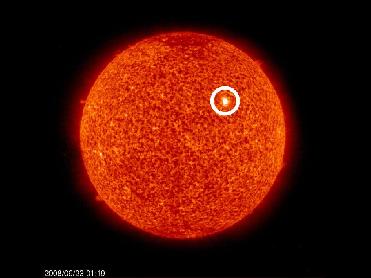
MUMBAI: For the first time in months, a significant sunspot is emerging on the Sun. It is a fast-growing active region with two dark cores, each larger than the Earth. The magnetic polarity of the sunspot identified it as a member of the new Sunspot Cycle 24.
Because this year brought so many blank Suns, some observers have wondered if we are ever going to climb out of the ongoing deep solar minimum, a NASA space weather alert said on Tuesday.
According to NASA astronomers, Tuesday's new sunspot is an encouraging sign that the 11-year solar cycle is indeed progressing, albeit slowly.
Senior astronomer Dr Mayank Vahia of the Tata Institute of Fundamental Research (TIFR) said that the number of sunspots on the Sun varies with time and they follow a sinusoidal (oscillatory) cycle of 11 years. The last solar cycle ended a couple of years ago.
“However, the sunspots have not recovered this time as fast as they should and some scientists have wondered if the Sun is going into a long-term quiet phase. A sunspot sighted now indicated that even if slowly, this cycle of sunspots is recovering,” Vahia said.
Sunspots are regions of the sun where a large concentration of magnetic field works like a bottle and isolates and cools the plasma on the surface of the Sun. Such regions appear dark in relation to the rest of the solar surface and hence these pimples on the surface are called sunspots.
Vahia said, even if the Sunspot cycle does not recover and the Sun goes into a decline, it does not mean a problem for earthlings. During 1645 and 1715, the Sun went through a period of quiet called the Maunder Minimum, after the scientist Maunder who first identified it in tree rings. No ill effect of this was felt on life on the Earth due to the quiet phase of solar activity. Since then, other such events have also been recorded in the past and none are associated with any changes in the Earth's weather, Vahia said.
These sunspots typically live for a few days and then their energy is released in the form of high-energy particles into inter planetary space and they often reach the earth. When they reach the earth, the earth's magnetic field deflects most of them and hence we do not feel their affect on Earth except for bright Aurora Borialis and Aurora Austrialis in the North and South Pole region.
However, for satellites in space, they can be harmful. Apart from affecting the Sun's magnetic field, they do not seem to have much affect on the stability of the Sun.
So whether solar cycle recovers, remains dull or catches up fast, we will see nothing dramatic on the Earth, Vahia said.(PTI)
 Next Article
Next Article













The Indian Air Force, in its flight trials evaluation report submitted before the Defence Ministry l..
view articleAn insight into the Medium Multi-Role Combat Aircraft competition...
view articleSky enthusiasts can now spot the International Space Station (ISS) commanded by Indian-American astr..
view article